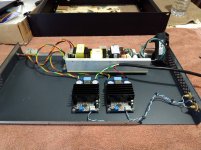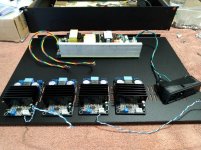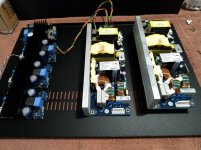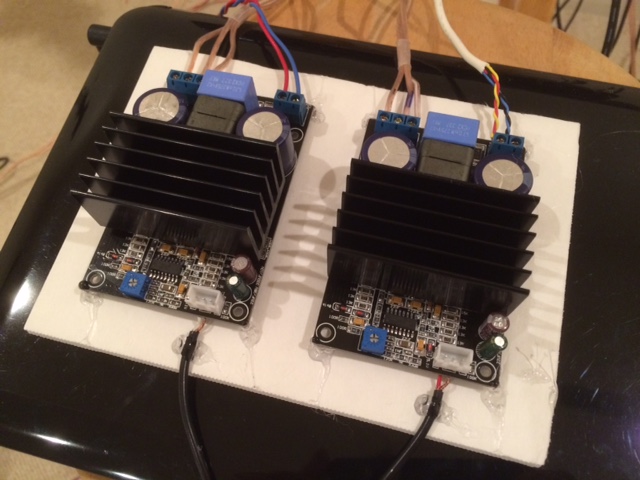Hi
i jumped into this thread and read quickly ....
what is the difference of the normal cheap IRS2092 boards (post 1) and the other amp baords L15D, L20D, L25D (didnt find) ??
i dont get the difference
thanks
chris
I'd guess its a matter of quality (of the PCBs themselves and the components) and the amp's performance and stability. I've read that digital amps can be sensitive to component placement, trace lengths, ground plane design and so on. But my 7-channel amp uses only LJM's L15D boards which are pretty close to the IRS2092 reference design and have worked flawlessly; I haven't tried the cheaper boards and they may be just fine - anyone else used them or have an opinion on them?
Cheers, Jon
I'd guess its a matter of quality (of the PCBs themselves and the components) and the amp's performance and stability. I've read that digital amps can be sensitive to component placement, trace lengths, ground plane design and so on. But my 7-channel amp uses only LJM's L15D boards which are pretty close to the IRS2092 reference design and have worked flawlessly; I haven't tried the cheaper boards and they may be just fine - anyone else used them or have an opinion on them?
Cheers, Jon
thanks Jon...
i realized that the L15-L20-L25 types of amps/boards grows up with their voltage but i see that it is related to the dfferent IRF MOSFETS to handle the current/power.
chris
Very nicely made, appear to be quality components
Appear to be quality components ?
How do you work that out by looking at them.
If you can that's very clever as I need test instruments to do that !
Got fed up with Chinese components after some blew up on me.
All I did was unplug a soldering iron !
So replaced bad components with genuine parts from RS Components and I couldn't blow them up no matter how much noise I put on the mains.
The fake parts obviously had a lower breakdown voltage to blow on a spike off the mains.
"Cheap", "ebay" or "Chinese" and I run for cover....
hhhmmm... as more as i read about this IRS2092...its interesting...but i need not more amps

Excellent little IC.
But, a lot of care has to go into the circuit and pcb design.
Took me 3 revisions of pcb to get one that worked without resetting on high volumes.
A picture is worth a thousand words so here goes.
I want to make a 4 channel amp for a low powered office system. I need ~100w on the bottom and <25w on the top of a bi-amped system.
I really think one supply would do it but of course I would like to hear from someone who has been running these a while.
Comments? Please.
Old test rig that worked great!

Proposed single supply:

Undesired layout:

I want to make a 4 channel amp for a low powered office system. I need ~100w on the bottom and <25w on the top of a bi-amped system.
I really think one supply would do it but of course I would like to hear from someone who has been running these a while.
Comments? Please.
Old test rig that worked great!

Proposed single supply:

Undesired layout:

Last edited:
Hi Nigel,
The only time I have had Chinese no-name caps blow up on me was when I applied either reverse polarity on them, or over-voltage on them. I have seen some of them bulge and replace them before they go. However, the quality of the aluminum can and shrink wrap labeling often gives the cheap ones away. Someone showed that they got a bunch of relabeled fake caps ("Nichicon" branded) by stripping of the fake wrap to reveal a razor knick made by the unscrupulous vendor who stripped of the wrap from a no-name and slipped counterfeit labels on the fake ones.
With that said, I agree that caution is needed and one should always wear safety goggles and step back a good 6 ft when powering up a new amp the first time, with or without fake caps and let it sit for a few minutes to take care of explosions.
The caps on this IRS2092 amp have not blown up with +/-53v applied to them and appear to not have bulged so a good sign.
I have had problems with fake Toshiba 2SC5200/2SA1943 transistors.
For all quality or critical builds, I get all my actives from reputable source like Mouser/Digikey/Arrow now.
Cheers,
X
Appear to be quality components ?
How do you work that out by looking at them.
If you can that's very clever as I need test instruments to do that !
Got fed up with Chinese components after some blew up on me.
All I did was unplug a soldering iron !
So replaced bad components with genuine parts from RS Components and I couldn't blow them up no matter how much noise I put on the mains.
The fake parts obviously had a lower breakdown voltage to blow on a spike off the mains.
"Cheap", "ebay" or "Chinese" and I run for cover....
The only time I have had Chinese no-name caps blow up on me was when I applied either reverse polarity on them, or over-voltage on them. I have seen some of them bulge and replace them before they go. However, the quality of the aluminum can and shrink wrap labeling often gives the cheap ones away. Someone showed that they got a bunch of relabeled fake caps ("Nichicon" branded) by stripping of the fake wrap to reveal a razor knick made by the unscrupulous vendor who stripped of the wrap from a no-name and slipped counterfeit labels on the fake ones.
With that said, I agree that caution is needed and one should always wear safety goggles and step back a good 6 ft when powering up a new amp the first time, with or without fake caps and let it sit for a few minutes to take care of explosions.
The caps on this IRS2092 amp have not blown up with +/-53v applied to them and appear to not have bulged so a good sign.
I have had problems with fake Toshiba 2SC5200/2SA1943 transistors.
For all quality or critical builds, I get all my actives from reputable source like Mouser/Digikey/Arrow now.
Cheers,
X
A picture is worth a thousand words so here goes.
I want to make a 4 channel amp for a low powered office system. I need ~100w on the bottom and <25w on the top of a bi-amped system.
I really think one supply would do it but of course I would like to hear from someone who has been running these a while.
Comments? Please.
Old test rig that worked great!
View attachment 751016
Proposed single supply:
View attachment 751017
Undesired layout:
View attachment 751018
Hi Troy
meanwhile this amps is interesting me...
as i read you have to start with this - phase inverter - correct?
to avoid rail pumping
https://www.diyaudio.com/forums/class-d/191739-design-l20d-irs2092-irfi4020h-200w8r-38.html#post2951879
as i understand its working for 2 channels too- correct?
chris
One issue encountered in single-ended (SE) class-D amplifier designs is supply pumping. Power-supply pumping is a rise in the local supply voltage due to energy being driven back to the supply by operation of the class-D
amplifier. This phenomenon is most evident at low audio frequencies and when both channels are operating at the same frequency and phase. At low levels, power-supply pumping results in distortion in the audio output due
to fluctuations in supply voltage. At higher levels, pumping can cause the overvoltage protection to operate, which temporarily shuts down the audio output. Several things can be done to relieve power-supply pumping. The lowest impact is to operate the two inputs out of phase 180° and reverse the speaker connections. Because most audio is highly correlated, this causes the
supply pumping to be out of phase and not as severe. If this is not enough, the amount of bulk capacitance on the supply must be increased. Also, improvement is realized by hooking other supplies to this node, thereby,
sinking some of the excess current. Power-supply pumping should be tested by operating the amplifier at low frequencies and high output levels.
datasheet TPA3122 - supply pumping
amplifier. This phenomenon is most evident at low audio frequencies and when both channels are operating at the same frequency and phase. At low levels, power-supply pumping results in distortion in the audio output due
to fluctuations in supply voltage. At higher levels, pumping can cause the overvoltage protection to operate, which temporarily shuts down the audio output. Several things can be done to relieve power-supply pumping. The lowest impact is to operate the two inputs out of phase 180° and reverse the speaker connections. Because most audio is highly correlated, this causes the
supply pumping to be out of phase and not as severe. If this is not enough, the amount of bulk capacitance on the supply must be increased. Also, improvement is realized by hooking other supplies to this node, thereby,
sinking some of the excess current. Power-supply pumping should be tested by operating the amplifier at low frequencies and high output levels.
datasheet TPA3122 - supply pumping
"Also, improvement is realized by hooking other supplies to this node, thereby,
sinking some of the excess current."
Sounds like more devices with different frequency spectrums would help.
Ill try hooking all 4 up to one supply and see how it goes.
Hi I'm thinking of doing the same, 4 amps hocked up to 1 SMPS, did you do that at the end? How did go?
Hi
thanks
psu is Abletec?
No PSU is: About china LLC smps

500W china LLC
I made some mesurement on other thread. You can have a look.
But amps are the same
Last edited:
- Home
- Amplifiers
- Class D
- 200W IRS2092 Amp for $20









